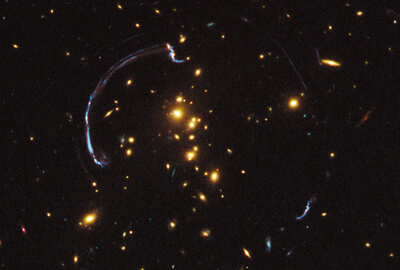A study led by Dr. Keren Sharon, formerly of Tel Aviv University and now at the University of Chicago, reveals that the photograph provides a glimpse into the evolution of galaxies 10 billion years ago

Thanks to the presence of "natural lenses" in space, the Hubble Space Telescope was able to focus on the brightest magnified galaxy discovered so far.
The observation provides a unique opportunity to study the physical properties of a galaxy in which vigorous star formation activity took place when the universe was about a third of its current age.
The so-called "gravitational lenses" are created when light passes on its way from the galaxy far away from us near a large body, whether it is a star, a black hole or even an entire galaxy cluster. The light from the more distant object is distorted, becoming brighter and magnified as it passes through the gravitationally disrupted region.
A team of astronomers led by Dr. Jane Rigby of NASA's Goddard Space Flight Center in Maryland aimed Hubble at one of the most spectacular examples of gravitational dusting, a nearly 90-degree arc of light in the galaxy cluster RCS2 032727-132623. The appearance of the background galaxy is much more detailed than would be obtained without the aid of gravitational lensing.
The results were accepted for publication in the Astrophysical Journal in an article led by Karen Sharon from the Kavli Institute for Cosmological Physics at the University of Chicago. Prof. Michael Gladers and research student Eva Waites from the University of Chicago were also partners in the team.
Dr. Karen Sharon, a graduate of Tel Aviv University, is currently completing a post-doctoral internship at the Kavli Institute for Cosmological Physics at the University of Chicago. Dr. Sharon's research focuses on the phenomenon of strong gravitational contraction in galaxy clusters, through which it is possible to both measure the mass of dark and visible matter in the cluster, and to use these clusters as powerful "telescopes" to amplify the light of distant galaxies. Her doctoral thesis dealt with measuring the supernova explosion rate in galaxy clusters as a function of their distance from us.
The presence of the lens helped show how galaxies have evolved from 10 billion years ago to the present day. While nearby galaxies are mature galaxies at the end of star formation, more distant galaxies teach us about the early days of the universe. The light from these early events is only now reaching Earth.
Very distant galaxies are not only pale but also appear small in the sky. Astronomers would be happy to see how the star formation process developed within these galaxies. Such details are often beyond Hubble's ability to observe without the amplification made possible by the gravity of the objects in the way.
In 2006, astronomers used the Very Large Telescope in Chile to measure the distance to the rainbow and determined that the galaxy appeared 3 times brighter than the dwarf galaxies discovered so far. In 2011, a Hubble team used Hubble's Wide Film Camera No. 3 to observe the dusty galaxy.
The disordered galaxy appears several times in the lensing cluster, as is often the case with gravitational lenses. The challenge for the astronomers was to reassemble the galaxy as it really looked, without the disruption of the circus mirror effect created by the cluster's gravity.
Using spectroscopic measurements - the breaking down of light into its component colors - the team members were able to analyze the star-forming regions to better understand why they produce so many stars.

4 תגובות
Research? That's the point of the matter
lens*
Since the galaxy is an optical witness for all intents and purposes, it has properties of normal optical lenses, such as focal length. From the assumption that similar galaxies have similar characteristics, it is possible to deduce the distances of bodies reflected through them as well as of the lenticular galaxies themselves. Have we done research in the field?
Were they able to analyze regions in the galaxy from 10 billion years ago???
crazy